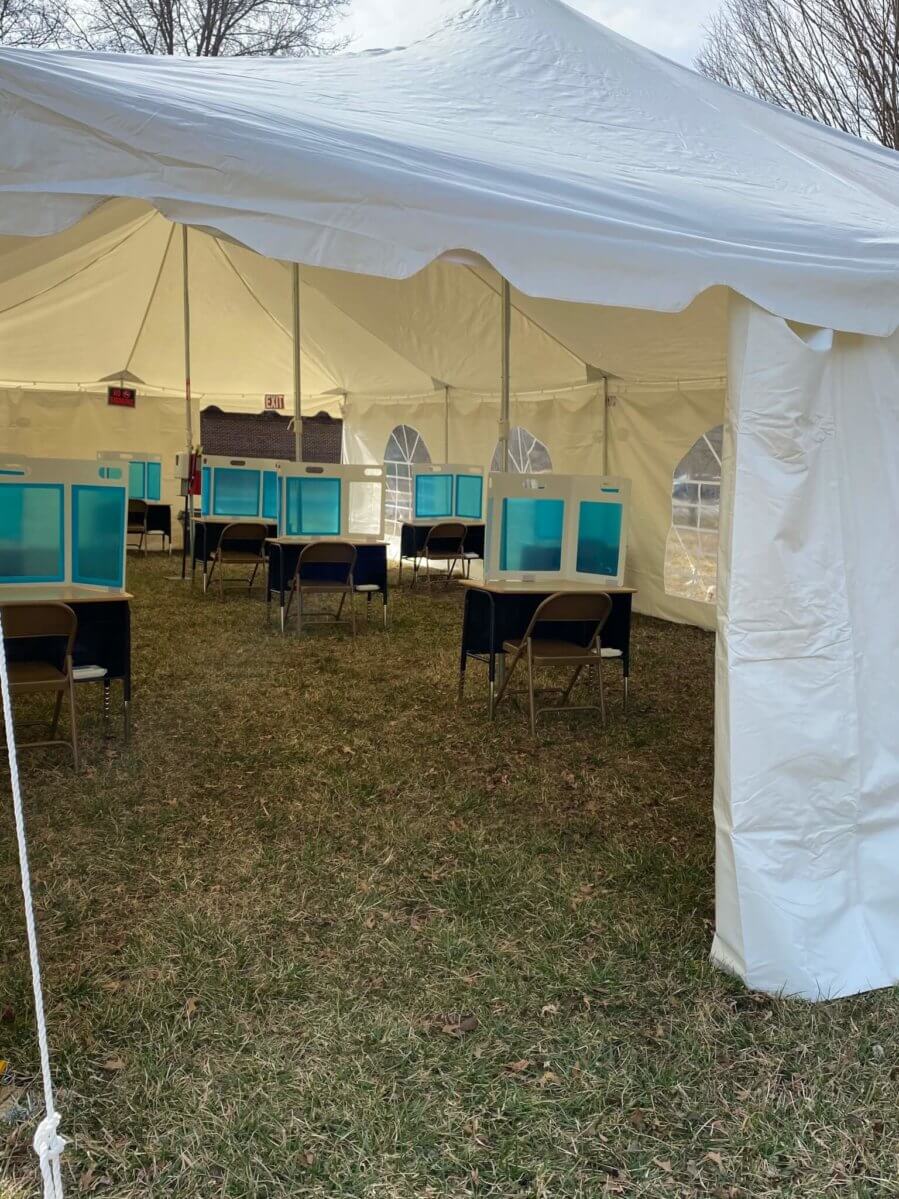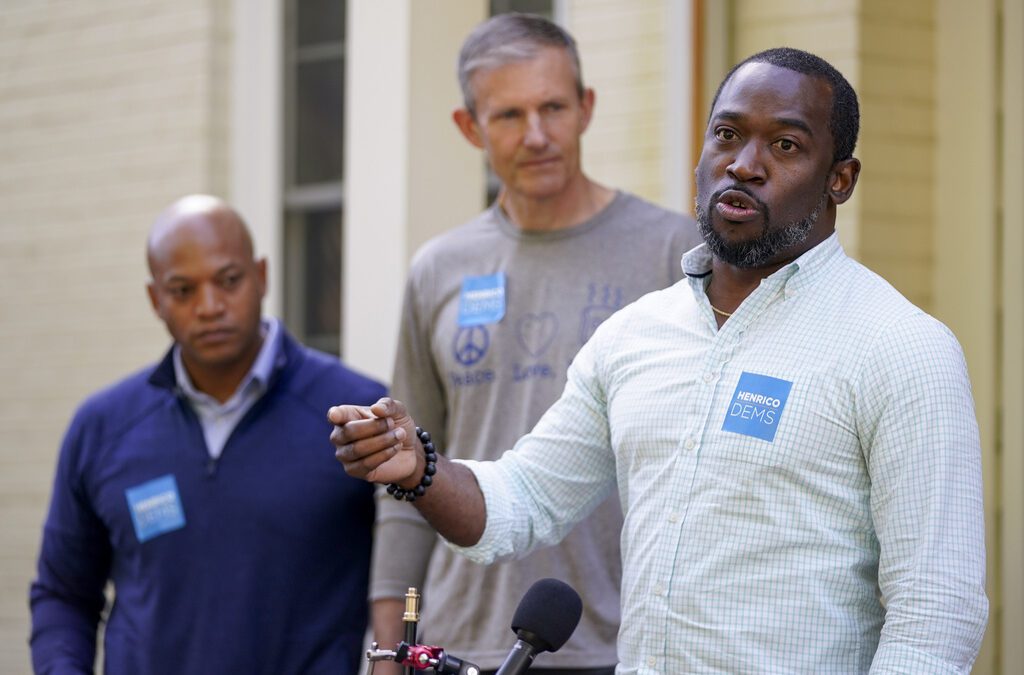
A look at some of the tent facilities used as virus mitigation methods by Montgomery County Schools.
In order to stay operational since August, Montgomery County Schools has used a variety of unique virus mitigation methods.
CHRISTIANSBURG – Recently, photos of big white tents on the grounds of various Montgomery County schools have been popping up on social media. The tents—reminiscent of those that usually host weddings or fancy outdoor cocktail parties—are eye-catching. But Montgomery County Public Schools Superintendent Mark Miear said they’re only one of many mitigation measures the district implemented before expanding in-person learning last week.
The district enrolls just shy of 10,000 students in the Southwest Virginia county that hosts Virginia Tech. For most of the school year, Miear said, students have attended school in-person. But classes were 50% smaller because students only attended for half the day. That changed on March 8.
Expanding In-Person Learning
Miear said during a March 12 call that for the most part, Montgomery County students have been attending school in-person since August.
“With the exception of a couple of periods where we pulled back some…because of high rates of infection,” Miear said, elementary students were in school for half-days, four days a week. Middle and high school students also attended for half-days, he added, but had full days of instruction because they joined class online after returning home.
Of course, all students had (and still have) the option to receive instruction online-only. Miear said about 25% of students have elected for all-online learning, although that number has been declining since last week.
“It’s actually going up every day, the number of students who are coming back (to school),” Miear said.
Like its neighbor to the south, the Floyd County school district, Montgomery County has reserved Wednesdays for cleaning facilities and teacher-student conferences.
“Teachers did office hours—still are, on Wednesdays—to meet with students,” Miear explained. “They’re meeting with them through Google Meet; anybody who needs extra help or extra assistance.”
Montgomery County Considers Metrics
District officials considered multiple factors before expanding in-person learning to four full days a week, Miear said. Updated guidance from the Virginia Department of Education and Virginia Department of Health, he explained, made bringing more kids into classrooms feasible.
The agencies now recommend that students maintain 3-6 feet of distance, Miear said, as opposed to the CDC’s firm six feet limit. “So we’re able to get more kids in with that criteria,” he said.
The school district also looked to the region’s New River Health District for guidance. The health district advised that in-person learning was safe, Miear said. “We really used our health department to guide us through this school year…and I think things have gone really well because of that,” he added.
Prior to expanding in-person learning, the district wanted to ensure that every teacher had an opportunity to be vaccinated. Miear said the health department helped make that happen, too.
Decision Was Controversial
Despite the seeming mandate from Gov. Ralph Northam that schools return to in-person learning by March 15, these decisions are still local. It’s up to each individual school district to make its own instructional plan. After much debate, Montgomery County’s School Board made the decision to expand in-person learning with a split 4-3 vote.
The decision has been controversial in the community. According to reporting by the Roanoke Times, the School Board surveyed students, parents, teachers and others prior to the decision. About half of all respondents showed “no support” for full school days.
Miear said the controversy is unsurprising. “These are controversial times. And there are folks that have different beliefs across the spectrum of this entire pandemic,” he said.
Miear suggested one factor that may have weighed more heavily for School Board members. Of the parents with children already attending school in-person, he said, a vast majority (75%) favored more in-person learning, not less. Sixty-four percent of all parents surveyed favored the change.
About Those Tents…
Montgomery County schools are doing everything possible to keep students safe, Miear said. Which brings us back to the tents.
For nearly the entire school day, Miear explained, students and teachers are required to wear face masks. In fact, during transitions between classes while students are walking the halls, they must be double-masked or wear a mask and a face shield. But folks were still worried about those times when students couldn’t wear masks—like during lunch.
“We thought of the idea that outdoors is safer than indoors, so why not give an outdoor dining option?” Miear explained. Parents can choose whether their children eat lunch in the outdoor venues, which have four walls but allow for a bit more airflow than inside. Seats inside the tents are spaced several feet apart.
Miear said the tents have varied in popularity from school to school. “Some schools requested three tents; some only have a couple (students) going to one tent. But it’s there. It’s an option for our families, for them to feel safer while at school,” he said.
CARES Act Funding Helped
Miear said local funding from the federal CARES Act helped the school district prepare for a return to in-person learning. “We couldn’t have done it without it, I promise you that,” Miear said.
In addition to the tents, the district has purchased high-quality air purification systems for every classroom. The units purchased are classified as HEPA-13, and are capable of filtering out the COVID virus. “One thing we really focused on compared to a lot of folks is air quality,” Miear said.
Montgomery County Public Schools officials also had a valuable local resource in Virginia Tech engineering professor Linsey Marr. Marr is an expert in aerosols who has been consulted by and quoted in publications nationwide. MCPS honed in on her advice to monitor carbon dioxide levels in the air as a proxy for measuring air circulation.
“We’re doing random checks on CO2 levels in classrooms,” Miear said. “(Marr’s) studies are something that we looked at…and we’re taking some of her recommendations.”
Politics

Democratic shakeup in Virginia primaries for governor, lieutenant governor
Richmond Mayor Levar Stoney quit his bid for governor and jumped into the race to be the Democratic nominee for lieutenant governor. The race for...

New Biden rule protects privacy of women seeking abortions
Under the new rules, state officials and law enforcement cannot obtain medical records related to lawful reproductive health care with the goal of...
Local News

Virginia verses: Celebrating 5 poetic icons for National Poetry Month
There’s no shortage of great writers when it comes to our commonwealth. From the haunting verses of Edgar Allan Poe, who found solace in Richmond's...

Join the fun: Recapping Family Literacy Night’s storybook adventures
When’s the last time you read a book aloud with a loved one? If it’s difficult to answer that question, then maybe it’s time to dust off that TBR...




